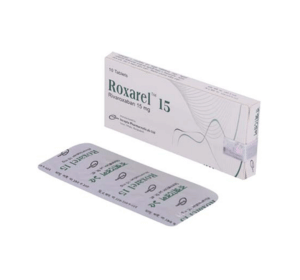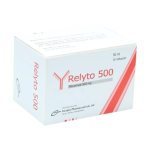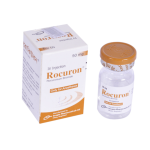Roxarel(Rivaroxaban)

Therapeutic Group: Cardiovascular
Presentation
Roxarel 10: Each Tablet contains Rivaroxaban INN 10 mg.
Roxarel 15: Each Tablet contains Rivaroxaban INN 15 mg.
Description
Rivaroxaban is a selective inhibitor of clotting factor Xa (FXa). It does not require a cofactor (such as Anti-thrombin III) for activity. Rivaroxaban inhibits free FXa and prothrombinase activity. Rivaroxaban indirectly inhibits platelet aggregation induced by thrombin. By inhibiting FXa, rivaroxaban decreases thrombin generation.
Indications
– Prevention of stroke and systemic embolism in adult patients with Non-valvular atrial fibrillation (AF) with one or more risk factors such as congestive heart failure, diabetes mellitus, hypertension, prior stroke or transient ischemic attack, age ≥ 75 years
– Treatment of deep vein thrombosis (DVT) and pulmonary embolism (PE), and prevention of recurrent DVT and PE in adults.
– For the prophylaxis of DVT, in patients undergoing knee or hip replacement surgery.
Dosage & Administration
– Prevention of stroke and systemic embolism in non-valvular AF: CrCl >50mL/min: 20 mg once daily with evening meal; CrCl 15 to 50 mL/min: 15 mg once daily with evening meal.
– Treatment of DVT and PE: 15 mg twice daily with food, for first 21 days. After 21 days, transition to 20 mg once daily with food, for remaining treatment.
Reduction in the risk of recurrence of DVT and PE: 20 mg once daily with food.
When converting patients from warfarin therapy to rivaroxaban, discontinue warfarin and start rivaroxaban when the INR is below 3.0.
In case of converting from rivaroxaban to warfarin, no clinical trial data are available for proper guidence. One approach is to discontinue rivaroxaban and begin both a parenteral anticoagulant and warfarin at the time the next dose of rivaroxaban would have been taken.
Converting from or to Anticoagulants other than Warfarin
For patients currently taking rivaroxaban and transitioning to an anticoagulant with rapid onset, discontinue rivaroxaban and give the first dose of the other anticoagulant (oral or parenteral) at the time that the next rivaroxaban dose would have been taken.
For patients currently receiving an anticoagulant other than warfarin, start rivaroxaban 0 to 2 hours prior to the next scheduled evening administration of the drug (e.g., low molecular weight heparin or non-warfarin oral anticoagulant) and omit administration of the other anticoagulant. For unfractionated heparin being administered by continuous infusion, stop the infusion and start rivaroxaban at the same time
Discontinuation for Surgery and Other Interventions
If anticoagulation must be discontinued to reduce the risk of bleeding with surgical or other procedures, rivaroxaban should be stopped at least 24 hours before the procedure. rivaroxaban should be restarted after the surgical or other procedures as soon as adequate hemostasis has been established. If oral medication cannot be taken during or after surgical intervention, consider administering a parenteral anticoagulant.
Prophylaxis of DVT Following Hip or Knee Replacement Surgery: For hip replacement: 10 mg once daily for 35 days; for knee replacement: 10 mg once daily for 12 days.
Side Effects
Haemorrhage, nausea, vomiting, diarrhoea, constipation, dyspepsia, abdominal pain, hypotension, dizziness, headache, renal impairment, pain in extremity, fever, peripheral oedema, fatigue. Other less common side effects include-thrombocythemia, allergic reaction, syncope, tachycardia, abnormal hepatic function.
Precautions
Premature discontinuation rivaroxaban, in the absence of adequate alternative anticoagulation increases the risk of thrombotic events. Rivaroxaban increases the risk of bleeding that can be fatal in presence of following risk factors- bleeding disorders, uncontrolled severe arterial hypertension, gastrointestinal disease (e.g., inflammatory bowel disease, oesophagitis, gastritis and gastroesophageal reflux disease), vascular retinopathy, bronchiectasis, history of pulmonary bleeding, Signs or symptoms of neurological impairment should be monitored in case of neuraxial anesthesia (spinal/epidural anesthesia) or spinal puncture as epidural or spinal hematoma can occur. Rivaroxaban is not recommended in patients with pulmonary embolism who present with hemodynamic instability or who may receive thrombolysis or pulmonary embolectomy.
Use in Pregnancy & Lactation
Pregnancy: Pregnancy category C.
There are no adequate and well-controlled studies in pregnant women.
Lactation: Safety and efficacy of Rivaroxaban have not been established in breast feeding women. A decision must be made whether to discontinue breast feeding or to discontinue/abstain from therapy.
Pediatric Use:
Safety and effectiveness of Rivaroxaban in pediatric patients have not been established.
Drug Interaction
Concomitant use with drugs that are combined P-gp and CYP3A4 inhibitors (ketoconazole, ritonavir, clarithromycin, erythromycin, fluconazole, diltiazem, verapamil, dronedarone), increases in rivaroxaban exposure and pharmacodynamic effects (i.e., factor Xa inhibition and PT prolongation) thus should be avoided. Co-administration of rivaroxaban with a combined P-gp and strong CYP3A4 inducer (e.g., rifampicin, phenytoin, carbamazepine) decreases efficacy of rivaroxaban and also should be avoided. The concomitant use of other drugs like- anti-platelet agents, heparin, fibrinolytic therapy, NSAIDs may cause increased risk of bleeding.
Over Dose
Overdose of rivaroxaban may lead to hemorrhage. Discontinue rivaroxaban and initiate appropriate therapy if bleeding complications associated with overdosage occur. A specific antidote for rivaroxaban is not available. The use of activated charcoal to reduce absorption in case of rivaroxaban overdose may be considered. Partial reversal of laboratory anticoagulation parameters may be achieved with use of plasma products.
Storage
Store at 25°C; excursions permitted to 15°-30°C.
Commercial Pack
Roxarel 10: Each box contains blister strips of 20 tablets
Roxarel 15: Each box contains blister strips of 10 tablets
Others
Geriatric Use:
The risk of thrombotic and bleeding events increases with age, but the risk-benefit profile is favorable in all age groups.
Renal impairment:
Nonvalvular Atrial Fibrillation: Avoid the use of rivaroxaban in patients with CrCl <15 mL/min. Periodically assess renal function as clinically indicated. Discontinue rivaroxaban in patients who develop acute renal failure while on rivaroxaban.
Treatment of Deep Vein Thrombosis (DVT), Pulmonary Embolism (PE), Reduction in the Risk of Recurrence of DVT and of PE and Prophylaxis of Deep Vein Thrombosis Following Hip or Knee Replacement Surgery: Avoid the use of rivaroxaban in patients with CrCl <30 mL/min.



